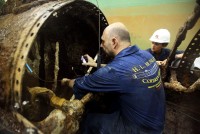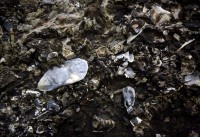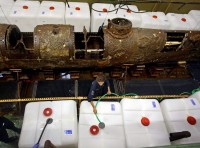 Last Thursday was the first day of approximately 1,825 days the Confederate submarine H. L. Hunley will spend immersed in a caustic bath of sodium hydroxide and water. This a watershed step in the conservation of the 40-foot iron submarine, a long bath 14 years in the making. The caustic bath will first remove the concretion, the thick layer of hardened shell and sand that formed on the hull of the sub during the 136 years it spent on the floor of Charleston Harbor since it sank the night of February 17th, 1864. The concretion completely covers the outside of the sub, obscuring the damage that might answer the questions about how and why the Hunley sank after successfully torpedoing the Union warship USS Housatonic.
Last Thursday was the first day of approximately 1,825 days the Confederate submarine H. L. Hunley will spend immersed in a caustic bath of sodium hydroxide and water. This a watershed step in the conservation of the 40-foot iron submarine, a long bath 14 years in the making. The caustic bath will first remove the concretion, the thick layer of hardened shell and sand that formed on the hull of the sub during the 136 years it spent on the floor of Charleston Harbor since it sank the night of February 17th, 1864. The concretion completely covers the outside of the sub, obscuring the damage that might answer the questions about how and why the Hunley sank after successfully torpedoing the Union warship USS Housatonic.
Michael Scafuri, Hunley archaeologist, said the concretion has been mapped, photographed and recorded with 3-D imaging to make sure they have every bit of information possible from the Hunley’s protective shell.
And now they are ready to see what lies beneath.
“Under that concretion is the possibility of new information about the attack,” Scafuri said.
With the shell and sand removed, Scafuri said scientists should learn more about the Hunley’s design and operations, and may be able to tell what caused the submarine to sink.
 The solution of 99% water and 1% sodium hydroxide should begin to loosen the concretion within a few months, giving conservators their first look at the hull in the 14 years since the submarine was raised from the Atlantic seabed. Once the concretion is loosened, conservators will scrape it off the hull, a painstaking process that will take months.
The solution of 99% water and 1% sodium hydroxide should begin to loosen the concretion within a few months, giving conservators their first look at the hull in the 14 years since the submarine was raised from the Atlantic seabed. Once the concretion is loosened, conservators will scrape it off the hull, a painstaking process that will take months.
After the scraping, the Hunley will settle in for the long soak. The sodium hydroxide has another important job to do: removing nearly a century and a half of sea salt from the iron hull. That’s the process that will take five years, with conservators regularly draining the 76,000 gallon tank of its 68,000 gallons of solution (large jugs of gravel and water in the tank displace 8,000 gallons) when it gets too salty.
 There are risks inherent in this procedure. Sodium hydroxide is a dangerous chemical and this treatment has never been used on so large an artifact. The lab had to be retrofitted for the safety of the space and its occupants. It’s the only way to ensure the long-term stability of the submarine, however. It’s been in a tank of cold water since its retrieval, for 11 years in a custom truss that kept it at the same angle as its had been on the ocean floor, then upright for three years. The water, a mild electric current and the concretion have preserved the hull for these initial conservation stages, but eventually the iron will corrode if the salt isn’t removed.
There are risks inherent in this procedure. Sodium hydroxide is a dangerous chemical and this treatment has never been used on so large an artifact. The lab had to be retrofitted for the safety of the space and its occupants. It’s the only way to ensure the long-term stability of the submarine, however. It’s been in a tank of cold water since its retrieval, for 11 years in a custom truss that kept it at the same angle as its had been on the ocean floor, then upright for three years. The water, a mild electric current and the concretion have preserved the hull for these initial conservation stages, but eventually the iron will corrode if the salt isn’t removed.
Once the salt is completely extracted, the Hunley will be able to be displayed outside of a tank for the first time.
Hold it! What about the $20 gold piece?
And what about the custom structure to house it in the decommissioned Charleston Navy Yard?
Sorry: [built] to house …